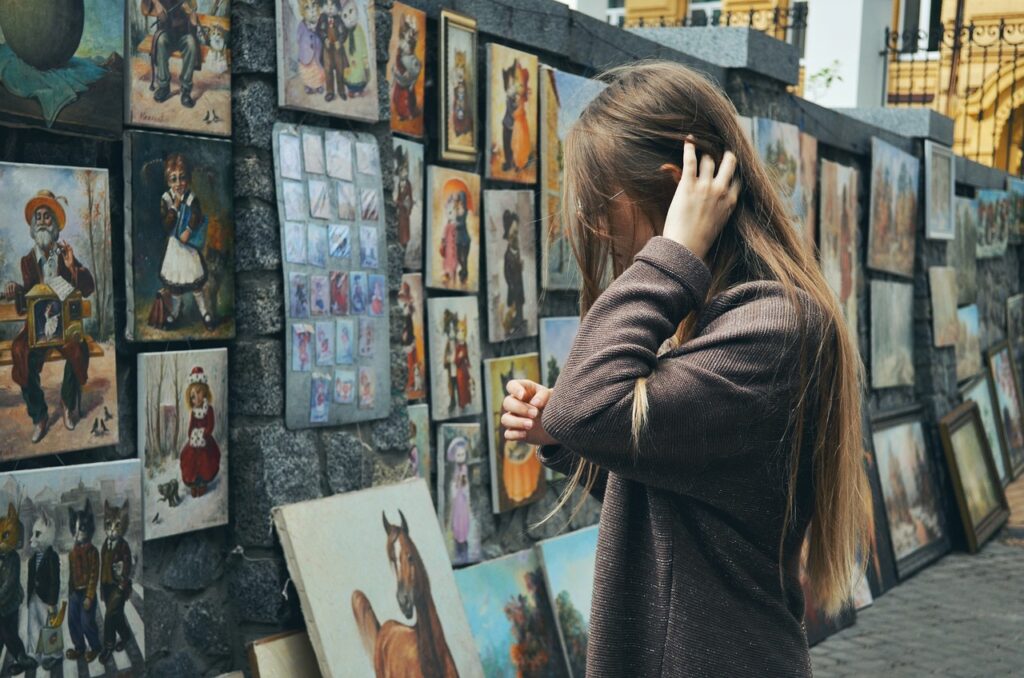
When it comes to buying art, some shoppers may have some common misconceptions; let’s explore them and uncover the realities.
#1: Art is expensive, you need a lot of money to buy it.
Art is often perceived as expensive, and many believe it requires a substantial budget to purchase. However, this is not always the case. There is a diverse array of art available at various price points. Affordable art is accessible, particularly when you consider works by emerging artists or opt for smaller pieces. It’s a misconception that all art necessitates a large financial investment.
See “Affordable Oil Paintings on Canvas.”
#2: Only expensive art by famous artists is good art.
The notion that only expensive art from famous artists is of good quality is a misconception. The value of art is not exclusively tied to its price tag or the artist’s fame; personal preference plays a significant role. Explore the works of lesser-known artists that strike a chord with you. Keep in mind that all renowned artists started as unknowns.
#3: You should only buy art from galleries.
The belief that art should only be purchased from galleries is a misconception. While galleries offer a curated selection, buying directly from artists can be beneficial. It fosters personal relationships, provides insight into their creative process, and may even allow for commissioned works.
#4: Art is an investment that always appreciates in value.
This is a mistaken belief. Although some artworks do appreciate in value, it is not a certainty. Purchase art for your affection for it, rather than just as an investment. Should it increase in value, regard that as an added benefit.
See “Buying Oil Paintings as an Investment.”
#5: Only experts can decide if art is “good.”
The perception that only experts can determine the value of art is a false assumption. In reality, the appreciation of art is highly subjective. Trust your own instincts—if a piece resonates with you, then it is good art for you. Art is not about aligning with the opinions of experts; it’s about the personal connection you feel with the work.
#6: You need lots of space to display art.
The assumption that you need ample space to display art is a misconception. In reality, art can enhance any area, regardless of size. For smaller spaces, options like miniatures, diptychs, or triptychs are ideal. Art enhances any environment, regardless of size.
See “Small Paintings for Small Spaces.”
#7: Your art must match your space perfectly.
The supposition that art must perfectly match your space is a myth. In reality, art should resonate, not necessarily match. Eclectic combinations can lead to vibrant visual dialogues. Trust your instincts and blend different styles if they appeal to you.
Remember, art is about enjoyment, expression, and personal connection. Break free from misconceptions, explore, and find pieces that enrich your life!
You May Also Like
FROM THE EDITORS: It is our hope that you have found the blog on common misconceptions about buying art both enlightening and beneficial. We believe you will appreciate the oil paintings displayed below. For further information and specifics, click or tap on the thumbnail link provided.

(2023)
12″ w x 9″ h

(2023)
9″ w x 12″ h

24″ w x 18″ h
Art Gallery Quick Links
Flowers | Landscapes | Marine | People
Space Art | Still Life | Wildlife
Additional Reading
Affordable Oil Paintings on Canvas
Buying Oil Paintings as an Investment
Small Paintings for Small Spaces
More information about this topic and many others can be found in My Artist Blog Index. Check it out!
Have a question?
If you have a question about this blog on common misconceptions about buying art, please contact us, and we’ll be happy to answer your questions.
Thanks for reading this!
Feel free to share this with your friends.

